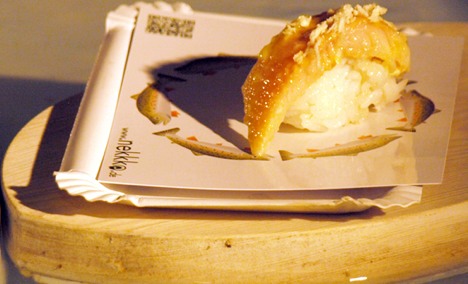The original concept of sushi was to serve fresh protein in a hygienic way using the natural preservatives of vinegar and ginger. It all began in the harbour of Tokyo, where the fish was served up fresh just after it had been caught in the bay. But now due to refrigeration, modern fishing techniques and popularity, it has become a worldwide phenomenon.
If you go out to a restaurant for sushi, it’s unlikely that you’re thinking about overfishing and just how far that piece of tuna has travelled to get to your plate. But a Berlin-based interdisciplinary performing arts collective called post theater, is trying to change the situation – one hungry customer at a time – through their sustainable sushi project.
“Sushi as we know it is a complete ecological disaster. So the only way is to re-think the very concept and have ingredients that are maybe not even fish, but that are fresh, that are wonderful, that are tasty and that have the same preciousness that sushi has,” said Max Schumacher from the group.
Schumacher and Hiroko Tanahashi have created both an ethical restaurant called “nekkko” and a performance. Almost all the ingredients are certified organic and sourced locally from Brandenburg, the eastern German state surrounding Berlin. However there are a couple of exceptions that are sourced elsewhere within Europe.
Schumacher explained that because there is no rice grown in Germany, they have to get that part of the sushi from Italy. The one ingredient they do have to import from Japan is nori – the seaweed – because they can’t get it anywhere else.
Schumacher and Tanahashi collaborated with Berlin-based chef, Ulli Krauss to develop the recipes.
It’s sushi – but not as you’ve ever tasted it. Krauss explained that the recipes are a fusion of sushi fundamentals like rice and nori, combined with European ingredients and seasoning.
Same, but different
The Galloway beef tartar maki is done in the classic French-style with capers and mustard. But people seemed a little hesitant to try this bright red morsel bursting out of its nori wrap.
The deer nigiri looks a little more laid back. A thin slice is draped over rice, accompanied by mirin and horseradish, and topped with cranberries. The deer comes from the Brandenburg forest.
“This is one of my favourites because we season the things like in the European kitchen. It is cooked, but rare inside – the consistency is like sushi – like raw fish,” explained Krauss.
Vegetarian options include tomato filets on rocket pesto (that look convincingly like tuna); beetroot with balsamic vinegar and honey; and carrot mousse with saffron, ginger and lime.
Krauss is particularly proud of the soy sauce they created. The base is beef stock and it’s a mix of all the cooking juices, combined with honey, ginger and herbs.
While some customers liked it, others would have preferred real soy sauce – or a vegetarian option. Everyone appreciated the concept of sustainable sushi, but one customer argued against having any meat on the menu.
Despite post theater’s focus on the ethics of fishing, Schumacher is adamant that they are not activists.
“We are artists and we have certain preferences and we have made a choice to be selective omnivores. In other words we try to avoid industrial produced meats and we don’t want to be guilty of overfishing, but it doesn’t mean we want to not eat any animal whatsoever,” said Schumacher. “We accept it as a position, but we don’t promote it ourselves.”
Sustainable Sushi was presented as a part of the recent Über Lebenskunst Festival at the House of World Cultures in Berlin.
For Max, a 30-year-old Berlin student, the Matjes Herring Maki was a clear favourite, while Lisa from Virginia preferred the pike with lemon and the taste-sensation of the bacon maki.
Schumacher from post theater hopes to inspire people to create their own sustainable sushi recipes and to take the mobile restaurant on the road.
“The dream is to tour internationally and to explore different regional solutions to the same question, because if we go to say another city in Germany or Europe, or anywhere in the world, we would have to ask ourselves about regional food there,” said Schumacher.
“What’s slow food there? What is the regional answer to our sustainable sushi question?”
If you’re keen on trying Sustainable Sushi, head over to Radialsystem V from 8–13 September where they’re taking part in the Asia Pacific Weeks in Berlin.
At Asien Pazifik-Wochen – Japan Fokus – Radialsystem V
Holzmarktstr. 33, 10243 Berlin
8–13 September from 6 pm
11 September from 11:00 am



 Please whitelist us to continue reading.
Please whitelist us to continue reading.
Member comments